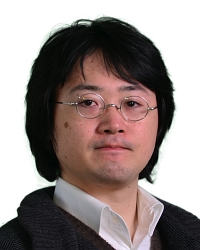TR2019-132
DNN-based Simultaneous Screen-to-Camera and Screen-to-Eye Communications
-
- , "DNN-based Simultaneous Screen-to-Camera and Screen-to-Eye Communications", IEEE Global Communications Conference (GLOBECOM), DOI: 10.1109/GLOBECOM38437.2019.9013967, December 2019.BibTeX TR2019-132 PDF
- @inproceedings{Fujihashi2019dec,
- author = {Fujihashi, Takuya and Koike-Akino, Toshiaki and Watanabe, Takashi and Orlik, Philip V.},
- title = {{DNN-based Simultaneous Screen-to-Camera and Screen-to-Eye Communications}},
- booktitle = {IEEE Global Communications Conference (GLOBECOM)},
- year = 2019,
- month = dec,
- publisher = {IEEE},
- doi = {10.1109/GLOBECOM38437.2019.9013967},
- issn = {2576-6813},
- isbn = {978-1-7281-0962-6},
- url = {https://www.merl.com/publications/TR2019-132}
- }
- , "DNN-based Simultaneous Screen-to-Camera and Screen-to-Eye Communications", IEEE Global Communications Conference (GLOBECOM), DOI: 10.1109/GLOBECOM38437.2019.9013967, December 2019.
-
MERL Contacts:
-
Research Areas:
Abstract:
Simultaneous screen-to-camera and screen-to-eye communications, i.e., watermarking, have been proposed in visible light communications. The main purpose of such communications is to provide many data bits for camera devices and visual information for human eyes by using a common displayed image. To this end, the existing studies leverage the capability discrepancy and distinctive features between the human vision system and camera devices. However, the existing techniques mainly require high refresh rates in both screen and camera devices to achieve better throughput while keeping high visual quality. In this paper, we propose a novel transmission scheme for efficient simultaneous screen-to-camera and screento-eye communications without a need of high refresh rates. Specifically, we use deep convolutional neural networks (DCNN)-based watermark encoder and decoder to embed many bits into high-quality images, and then to maximize throughput from the bit-embedded image. With end-to-end adversarial learning, the encoder networks learn a mapping function to embed digital data into an original image based on a perceptual loss function while the decoder networks also learn a mapping function from the bitembedded image to the data bits based on a cross-entropy loss function. From the evaluations, we show that the proposed watermark encoding and decoding networks yield high throughput from the bit-embedded images compared with a simple DCNNbased watermarking. In addition, the bit-embedded images on the screen achieve high quality for human perception.
Related News & Events
-
NEWS MERL Scientists Presenting 11 Papers at IEEE Global Communications Conference (GLOBECOM) 2019 Date: December 9, 2019 - December 13, 2019
Where: Waikoloa, Hawaii, USA
MERL Contacts: Jianlin Guo; Toshiaki Koike-Akino; Philip V. Orlik; Pu (Perry) Wang
Research Areas: Communications, Computer Vision, Machine Learning, Signal Processing, Information SecurityBrief- MERL Signal Processing scientists and collaborators will be presenting 11 papers at the IEEE Global Communications Conference (GLOBECOM) 2019, which is being held in Waikoloa, Hawaii from December 9-13, 2019. Topics to be presented include recent advances in power amplifier, MIMO algorithms, WiFi sensing, video casting, visible light communications, user authentication, vehicular communications, secrecy, and relay systems, including sophisticated machine learning applications. A number of these papers are a result of successful collaboration between MERL and world-leading Universities including: Osaka University, University of New South Wales, Oxford University, Princeton University, South China University of Technology, Massachusetts Institute of Technology and Aalborg University.
GLOBECOM is one of the IEEE Communications Society’s two flagship conferences dedicated to driving innovation in nearly every aspect of communications. Each year, more than 3000 scientific researchers and their management submit proposals for program sessions to be held at the annual conference. Themed “Revolutionizing Communications,” GLOBECOM2019 will feature a comprehensive high-quality technical program including 13 symposia and a variety of tutorials and workshops to share visions and ideas, obtain updates on latest technologies and expand professional and social networking.
- MERL Signal Processing scientists and collaborators will be presenting 11 papers at the IEEE Global Communications Conference (GLOBECOM) 2019, which is being held in Waikoloa, Hawaii from December 9-13, 2019. Topics to be presented include recent advances in power amplifier, MIMO algorithms, WiFi sensing, video casting, visible light communications, user authentication, vehicular communications, secrecy, and relay systems, including sophisticated machine learning applications. A number of these papers are a result of successful collaboration between MERL and world-leading Universities including: Osaka University, University of New South Wales, Oxford University, Princeton University, South China University of Technology, Massachusetts Institute of Technology and Aalborg University.

